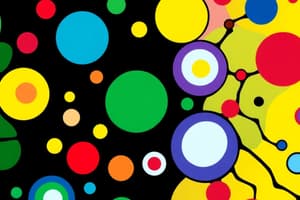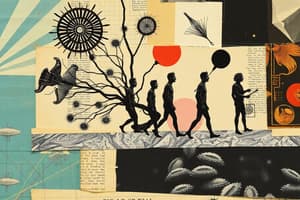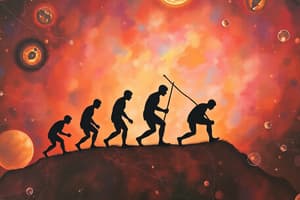Podcast
Questions and Answers
Which of the following is the most direct application of the gene theory in understanding biological inheritance?
Which of the following is the most direct application of the gene theory in understanding biological inheritance?
- Predicting the frequency of heterozygous genotypes in a population using the Hardy-Weinberg principle.
- Describing the process of natural selection acting on phenotypic variations within a population.
- Tracing the evolutionary history of a species through comparative genomics.
- Explaining how traits are passed from parents to offspring through specific units of inheritance. (correct)
How does the organization of tissues into organs demonstrate an emergent property in biological systems?
How does the organization of tissues into organs demonstrate an emergent property in biological systems?
- Organs perform functions that are more complex and diverse than the functions of the individual tissues comprising them. (correct)
- Organs maintain the same level of homeostasis as individual tissues, ensuring functional redundancy.
- Organs are composed of multiple tissue types but perform the same functions as individual tissues.
- Organs are simpler in structure compared to tissues, allowing for more efficient metabolic processes.
What is the functional consequence of the unique structural properties of lipids in biological systems?
What is the functional consequence of the unique structural properties of lipids in biological systems?
- They facilitate rapid transport of genetic information within cells.
- They form selectively permeable barriers that define cellular boundaries. (correct)
- They catalyze biochemical reactions with high specificity.
- They provide rigid structural support to plant cell walls.
The presence of membrane-bound organelles in eukaryotic cells allows for which of the following?
The presence of membrane-bound organelles in eukaryotic cells allows for which of the following?
How do enzymes facilitate biochemical reactions within living organisms?
How do enzymes facilitate biochemical reactions within living organisms?
What is the significance of complementary base pairing in the DNA double helix for genetic inheritance?
What is the significance of complementary base pairing in the DNA double helix for genetic inheritance?
What distinguishes meiosis from mitosis in eukaryotic cells?
What distinguishes meiosis from mitosis in eukaryotic cells?
Which of the following scenarios best illustrates natural selection?
Which of the following scenarios best illustrates natural selection?
How does the concept of trophic levels explain the flow of energy within an ecosystem?
How does the concept of trophic levels explain the flow of energy within an ecosystem?
In the context of biological diversity, how do the three domains of life differ in cellular structure and environmental adaptation?
In the context of biological diversity, how do the three domains of life differ in cellular structure and environmental adaptation?
What is the evolutionary significance of flowers in plant biology?
What is the evolutionary significance of flowers in plant biology?
How do the nervous and endocrine systems coordinate to maintain homeostasis in animals?
How do the nervous and endocrine systems coordinate to maintain homeostasis in animals?
What role do microorganisms play in nutrient cycling within ecosystems?
What role do microorganisms play in nutrient cycling within ecosystems?
How does biotechnology contribute to advancements in medicine?
How does biotechnology contribute to advancements in medicine?
How does understanding human biology inform strategies for promoting public health?
How does understanding human biology inform strategies for promoting public health?
Flashcards
Biology
Biology
The scientific study of life, including its structure, function, growth, origin, evolution, and distribution.
Cell Theory
Cell Theory
All living organisms are composed of cells.
Gene Theory
Gene Theory
Heredity occurs through genes, the units of inheritance.
Evolution
Evolution
Signup and view all the flashcards
Homeostasis
Homeostasis
Signup and view all the flashcards
Cell
Cell
Signup and view all the flashcards
Organic Molecules
Organic Molecules
Signup and view all the flashcards
Carbohydrates
Carbohydrates
Signup and view all the flashcards
Lipids
Lipids
Signup and view all the flashcards
Proteins
Proteins
Signup and view all the flashcards
Nucleic Acids
Nucleic Acids
Signup and view all the flashcards
Prokaryotic Cell
Prokaryotic Cell
Signup and view all the flashcards
Eukaryotic Cell
Eukaryotic Cell
Signup and view all the flashcards
Plasma Membrane
Plasma Membrane
Signup and view all the flashcards
Enzymes
Enzymes
Signup and view all the flashcards
Study Notes
- Biology is the scientific study of life
- It explores the structure, function, growth, origin, evolution, and distribution of living organisms
Core Principles of Biology
- Cell theory: all living organisms are composed of cells
- Gene theory: heredity occurs through genes, units of inheritance
- Evolution: populations evolve over time
- Homeostasis: living organisms maintain a stable internal environment
Levels of Biological Organization
- Molecules: atoms combine to form molecules, such as DNA and proteins
- Cells: the basic unit of life, consisting of organelles and other structures enclosed by a membrane
- Tissues: similar cells performing a specific function
- Organs: different tissues organized to perform specific functions
- Organ systems: organs working together
- Organisms: individual living entities
- Populations: groups of individuals of the same species in a given area
- Communities: populations of different species in a given area
- Ecosystems: communities and their nonliving environment
- Biosphere: all ecosystems combined – the regions of Earth inhabited by life
Chemistry of Life
- Living organisms are composed of organic molecules, which contain carbon
- Key organic molecules include carbohydrates, lipids, proteins, and nucleic acids
- Carbohydrates: provide energy and structural support
- Lipids: store energy, form cell membranes, and act as hormones
- Proteins: perform various functions, including enzymes, structural components, and transport
- Nucleic acids (DNA and RNA): carry genetic information
Cell Structure and Function
- Cells are either prokaryotic or eukaryotic
- Prokaryotic cells: lack a nucleus and other membrane-bound organelles (e.g., bacteria)
- Eukaryotic cells: contain a nucleus and other membrane-bound organelles (e.g., animal, plant, fungi, and protist cells)
- Key cell structures:
- Plasma membrane: regulates the movement of substances in and out of the cell
- Nucleus: contains the cell's DNA
- Ribosomes: synthesize proteins
- Endoplasmic reticulum (ER): involved in protein and lipid synthesis
- Golgi apparatus: modifies, sorts, and packages proteins
- Mitochondria: produce energy through cellular respiration
- Chloroplasts (in plant cells): conduct photosynthesis
- Lysosomes: break down waste materials and cellular debris
Energy and Metabolism
- Metabolism: all chemical reactions that occur in an organism
- Enzymes: proteins that catalyze (speed up) chemical reactions
- Cellular respiration: process by which cells break down glucose to produce ATP, the energy currency of the cell
- Photosynthesis: process by which plants and other organisms convert light energy into chemical energy in the form of glucose
Genetics
- Genes: units of heredity made of DNA
- DNA: deoxyribonucleic acid, the molecule that carries genetic information
- DNA structure: double helix composed of nucleotides, each consisting of a sugar, phosphate group, and nitrogenous base (adenine, thymine, guanine, or cytosine)
- RNA: ribonucleic acid, involved in protein synthesis
- Gene expression: the process by which the information encoded in a gene is used to synthesize a functional gene product (protein or RNA)
- Transcription: DNA is transcribed into mRNA
- Translation: mRNA is translated into protein at the ribosome
Cell Division
- Cell division is essential for growth, repair, and reproduction
- Mitosis: cell division that results in two identical daughter cells; used for growth and repair
- Meiosis: cell division that results in four daughter cells with half the number of chromosomes; used for sexual reproduction
Evolution
- Evolution: change in the heritable characteristics of biological populations over successive generations
- Natural selection: differential survival and reproduction of individuals with certain traits
- Adaptation: inherited traits that enhance an organism's survival and reproduction in a specific environment
- Evidence for evolution:
- Fossil record
- Comparative anatomy
- Embryology
- Biogeography
- Molecular biology
Ecology
- Ecology is the study of the interactions between organisms and their environment
- Population ecology: studies the factors that affect population size and density
- Community ecology: studies the interactions between different species in a community
- Ecosystem ecology: studies the flow of energy and cycling of nutrients in an ecosystem
- Key ecological concepts:
- Biotic factors: living components of an ecosystem
- Abiotic factors: nonliving components of an ecosystem (e.g., temperature, water, sunlight)
- Food webs: illustrate the flow of energy through an ecosystem
- Trophic levels: position an organism occupies in a food web (e.g., producers, consumers, decomposers)
- Biomes: large geographic areas characterized by specific climate conditions and plant communities
Biological Diversity
- Biodiversity: the variety of life at all levels of biological organization
- Three domains of life:
- Bacteria: prokaryotic microorganisms
- Archaea: prokaryotic microorganisms that often live in extreme environments
- Eukarya: organisms with eukaryotic cells (protists, fungi, plants, and animals)
- Classification of organisms:
- Kingdom
- Phylum
- Class
- Order
- Family
- Genus
- Species
Plant Biology
- Plants are multicellular, eukaryotic organisms that conduct photosynthesis
- Key plant structures:
- Roots: anchor the plant and absorb water and nutrients
- Stems: support the plant and transport water and nutrients
- Leaves: conduct photosynthesis
- Flowers: involved in sexual reproduction
- Plant reproduction:
- Sexual reproduction: involves pollination and fertilization
- Asexual reproduction: involves vegetative propagation (e.g., cuttings, grafting)
Animal Biology
- Animals are multicellular, eukaryotic organisms that are heterotrophic (obtain nutrients by consuming other organisms)
- Key animal characteristics:
- Movement
- Sensory systems
- Nervous system
- Endocrine system
- Digestive system
- Respiratory system
- Circulatory system
- Excretory system
- Reproductive system
- Animal classification: based on body plan, development, and genetic characteristics
Microbiology
- Microbiology is the study of microorganisms, including bacteria, archaea, viruses, fungi, and protists
- Microorganisms play important roles in:
- Nutrient cycling
- Decomposition
- Disease
- Biotechnology
Human Biology
- Human biology is the study of the human body, including its anatomy, physiology, and genetics
- Key human organ systems:
- Integumentary system (skin)
- Skeletal system (bones)
- Muscular system (muscles)
- Nervous system (brain, spinal cord, nerves)
- Endocrine system (glands and hormones)
- Cardiovascular system (heart and blood vessels)
- Lymphatic system (immune system)
- Respiratory system (lungs)
- Digestive system (stomach, intestines)
- Urinary system (kidneys, bladder)
- Reproductive system (ovaries, testes)
Biotechnology
- Biotechnology involves the use of biological systems to create products or processes
- Applications of biotechnology:
- Medicine (e.g., vaccines, gene therapy)
- Agriculture (e.g., genetically modified crops)
- Environmental science (e.g., bioremediation)
- Forensics (e.g., DNA fingerprinting)
Studying That Suits You
Use AI to generate personalized quizzes and flashcards to suit your learning preferences.




